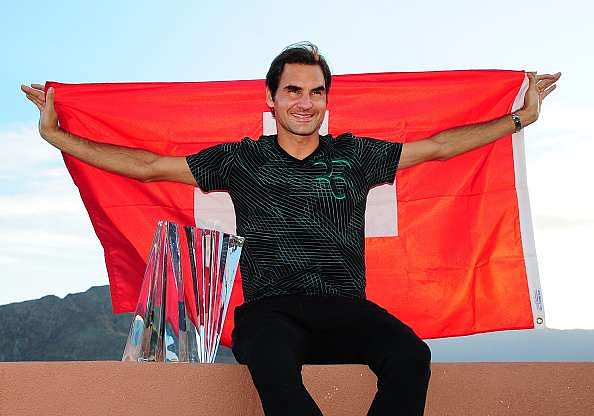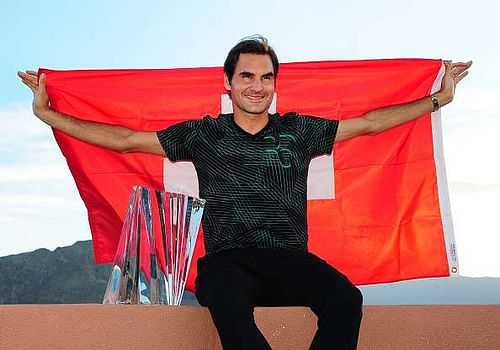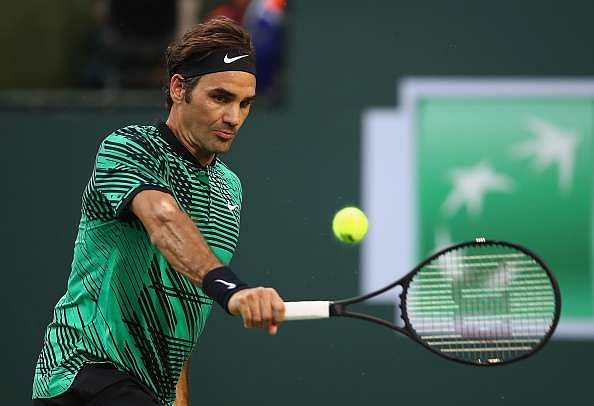
The question has to be asked: Is Roger Federer playing the best tennis of his career right now?
The match point has always been a source of endless fascination in tennis. If it ends the match, it is replayed countless times to remind people that this was the moment that decided the two players’ fate. If it is saved, and the saver goes on to win the match, it is again replayed countless times to reinforce how closely the eventual winner flirted with disaster, before producing nerves of steel to turn the tide.
It's our good fortune that we've been witness to plenty of fabulous match points in our time. The one in the match between Andy Roddick and Milos Raonic at the 2011 Memphis event left us spell-bound with its sheer improbability (spoiler: a dive was involved). And on some really lucky occasions, like the 2013 Australian Open fourth round, we were given two otherworldly match points in the same game – one that went the way of Wawrinka, the loser, and another that finally ended the match in Djokovic's favour.
But rarely do we get to see a match point that perfectly encapsulates the best attributes of the winner, the way we did in the Indian Wells final yesterday between Roger Federer and Stan Wawrinka.
There was the return taken on the rise to start the point in a way only Federer can. There was the acutely angled backhand that almost painted the line, drawing Wawrinka out of position. There was the safe yet forceful inside-in forehand that set up the kill shot. And finally, there was the panther-like sprint to the net, which put him in position to end the match with the simplest of volleys.
The California desert had been treated to a Federer special, and the all-encompassing match point was the most emphatic conclusion to the spectacular show that anyone could have hoped for.
But the discussions since last night haven't centred around this point, or even this match. Instead, the thing that has consumed most tennis watchers all week has been Federer's display of dominance; we haven't seen him mow down the field like this for nearly a decade (except at Cincinnati, which is his personal playground).
It sounds ridiculous that we are even asking this of a man who's going to turn 36 this year, but is Federer playing the best tennis of his career right now?
When you look at the numbers, it's tempting to say ‘yes’ to that right away. Federer didn't drop a set all week, despite facing two future Hall-of-Famers on his way to the title. He dropped serve just once in the entire tournament, and that too only in the second set of the final – when Wawrinka suddenly went into ‘Stanimal’ mode, firing three outrageous winners that threatened to burn holes in the court. But most significantly, he notched up his most one-sided outdoor hardcourt win over Rafael Nadal, thus eclipsing the best efforts of even the 2006 version of Federer.
He is also, without a shadow of a doubt, hitting his backhand better than ever. The man has been playing tennis for close to 20 years, but never has his backhand looked this good for this long. Both his wins over Nadal this year were set up by the suddenly-devastating ability of his backhand to find winners out of nowhere – his eight backhand winners in the decider at Melbourne are well-documented, and at Indian Wells he clinched two out of his four service breaks with backhand winners.
Against Wawrinka yesterday, he sliced his backhand more than he had done all week, because he had to. When Wawrinka is unloading on his groundstrokes, you simply don't have the time to come over your shots the way you do against other players. Heck, Federer even sliced his forehand in the final more than he had against any other player, because that's what Wawrinka's thunderbolts make you do.
Despite that though, Federer still managed to quadruple Wawrinka's backhand winner count. He hit eight backhand winners in the match, to Wawrinka's two. That's right; Federer hit more winners off the backhand – four times as many – than the man widely considered to possess the heaviest single-handed backhand in the history of tennis.
That's the kind of statistic that inspires the popular ‘What kind of sorcery is this?’ meme. It's just hard to wrap your head around it.
Ivan Ljubicic's coaching has probably contributed to the turnaround. Ljubicic may not have had the most memorable single-hander in history, but he knew the value of standing your ground with the shot from the baseline, and hammering away with it even if it leaked errors. And Federer being who he is, has ensured that it doesn't leak errors even when he's going at it full throttle all the time.
Is that all he needed all these years? A mental push to ‘hit’ his backhand rather than slice it? If Federer is to be believed, his father Robert has been trying to get him to do that since forever. “He's the first to tell me, ‘Hit the backhand, dammit! Don't just fall back and slice all the time,” Federer said earlier this week.
Clearly, Ljubicic has proven to be more persuasive than the elder Federer. But maybe it's about more than just having someone tell you to do something, and then going ahead and doing it. If it were that easy, everyone would've hit topspin backhands all the time, and the slice would have never been invented.
There's something else at play too, something that hadn't been there for the last five years.
Could it be...the small matter of finally capturing the elusive No. 18? “Winning Australia, it solves so many problems,” Federer said in his recent interview with GQ.
The Swiss had been struggling for so long to add to his Major tally, and had to come up with so many changes to remain relevant in the Nadal-Djokovic era, that he probably forgot what it meant to play freely. There was always the pressure of having failed to ‘get the job done’ the last four years, the fear of stumbling at the last hurdle over and over again, the danger of being pushed into retirement ealier than he would have liked.
But now that he's got No. 18 in the bag, he seems to have rediscovered the spring in his step and the carefree shot-making that made him such an irresistible force in his peak years. You can't just decide to hit fierce topspin backhands and then go out and make them; you need to be free of fear to be able to commit to that kind of relentless attack. Federer always had a brilliant backhand in his repertoire; he just didn't have the confidence to rely on it often enough.
And the court positioning. My god, the court positioning. A year ago I had written about how Federer plays unlike any other player that I've seen, stubbornly sticking to the baseline no matter how hard the opponent is hitting. But now, he has taken that style a step further, both literally and figuratively. All through this week, and also during the Australian Open, he showed a scary, almost suicidal eagerness to hit the ball with as much forward momentum as humanly possible. It seems like he has decided that retreating behind the baseline is not an option for him anymore; he'd either win by half-volleying everything, or lose amid a hail of errors (read: Evgeny Donskoy).
Again though, such a kamikaze approach to his tennis wouldn't have been possible unless he felt he had nothing to lose. And he actually has nothing to lose right now; at the age of 35, the fact that he's even in the top 10 is an achievement in itself. That he's also winning Slams, and making an as-yet-unconfirmed-but-not-laughable-anymore march to the World No. 1 ranking, is the mother of all bonuses (you can read what he said about the No. 1 issue here).
But all that still doesn't answer the question: is he playing better right now than he was in 2006? I'd say yes with the backhand, but no with the movement. For all of his recent successes, it's hard to shake off the idea that his foot speed just isn't what it used to be.
Don't believe me? Take a look at some of his best points from 2006 in the video below. The common thread in nearly all of them is how darned quick he was; his passing shots were positively Nadal-esque (or Djokovic-esque, depending on your preference).
A highlights package is probably not the best way to judge the median level of a player. Sure he looked fantastic in all these points, but was he just as good from one day to another, and from one event to the next?
Unfortunately, there's no way to definitively judge that, because of two reasons: 1. Full match replays aren't available of all of Federer's 2006 and 2017 matches, and 2. Even if they were available, it would take hundreds of hours of non-stop tennis watching to arrive at a fully informed conclusion.
We do have the next best option though: a collection of his best points from this year's Australian Open and Indian Wells.
It doesn't take long to identify the main difference between Federer's 2006 highlights and his 2017 ones. In 2006, he relied on his court coverage and purity of shot-making to stun the rest of the field into submission. But in 2017, he has had to employ lunges, stretches, improvisations, sleights of hand and good old wrong-footing to best his opponents.
That's not to say there's anything wrong with his 2017 methods. If you can't beat your opponent with sheer force, it makes sense to find other ways to do it. And Federer, bless his heart, has always been a master at adaptation.
Here are the tangibles that we can break down: his serve has remained roughly the same; his forehand, while more temperamental now, is just as effective as it used to be when it's on song; his backhand is better now; his movement was better back then.
To my mind, it comes down to this: if you had to choose between an unstoppable backhand and unbelievable foot-speed, what would you opt for? It's a subjective matter, but I personally would pick foot-speed. Superior movement can help you mask a less-than-reliable backhand, but a superlative backhand can't help you retrieve the bullets that the likes of Wawrinka and Dominic Thiem are capable of unleashing.
Federer has still been winning, so for the moment at least, the question is moot. But at his age, it's hard not to wonder how long his dominant streak can last. He's hitting his backhand with unparalleled authority right now, but will he still be doing that come the clay season and Nadal's tremendous topspin bombs? He's outwitting everyone with his variety and net play right now, but can he maintain that even if the likes of Andy Murray chase down everything and make him hit 5-6 extra shots every point?
Maybe he will, maybe he won't. But what is clear as day right now is that Federer hasn't stopped trying to improve, even though his body has started betraying him more often. He didn't really bring out a ‘new’ backhand this week, but he HAS come up with a never-seen-before shot-making template: hit the ball ridiculously early, no matter what the outcome.
I don't know about you, but I for one am very intrigued to see what Federer comes up with if (or when) this new strategy starts showing cracks. Will he try and volley everything, refusing to ever let the ball bounce? Knowing Federer, that's not completely impossible.

